Saltwater Fish Details
Quick Links
Almaco Jack | American Shad | Atlantic Sharpnose Shark | Atlantic Croaker | Banded Rudderfish | Bank Sea Bass | Black Grouper | Black Sea Bass | Black Drum | Blackfin Snapper | Blue Runner | Blue Marlin | Bluefish | Bonefish | Bonnethead Shark | Cero | Cobia | Common Snook | Crevalle Jack | Cubera Snapper | Dog Snapper | Dolphin | Fantail Mullet | Fat Snook | Florida Pompano | Gag Grouper | Goliath Grouper | Gray Snapper | Greater Amberjack | Gulf Flounder | King Mackerel | Ladyfish | Lane Snapper | Lesser Amberjack | Longbill Spearfish | Mahogany Snapper | Mutton Snapper | Nassau Grouper | Palometa | Permit | Queen Snapper | Red Drum | Red Grouper | Red Snapper | Rock Sea Bass | Sailfish | Sand Seatrout | Sandbar Shark | Scalloped Hammerhead | Scamp | Schoolmaster | Sheepshead | Shortfin Mako | Silk Snapper | Silver Seatrout | Silver Perch | Spanish Mackerel | Spotted Seatrout | Striped (Black) Mullet | Swordfish | Swordspine Snook | Tarpon Snook | Tarpon | Vermillion Snapper | Weakfish | White Marlin | White Grunt | Yellowfin Grouper | Yellowmouth Grouper | Yellowtail Snapper
Silk Snapper

Back and upper sides pinkish red, shading to silvery sides with undulating yellow lines; pecorals pale yellow; back edge of caudal fin blackish; anal fin pointed; no dark lateral spot.
Where Found:
OFFSHORE over rocky ledges in very deep water; most common is south Florida.
Size:
Usually less than 5 pounds.
Remarks:
Little is known.
Silver Sea Trout
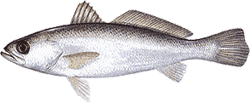
Pale straw colored above, silvery sides and white below; no distinctive pigmentation, although faint diagonal lines may be present on upper body; 8 to9 rays in the anal fin; large eyes; short snout; one or two prominent canine teeth usually present at tip of upper jaw; lower half of tail longer than upper half.
Where Found:
Most common over sand or sandy mud bottoms OFFSHORE along both the Gulf and the Atlantic coasts of Florida; migrates into bays during cold months.
Size:
Usually no more than 1/2 pound (less than 10 inches)
Remarks:
Smallest seatrout; spawns OFFSHORE in deep water during spring, summer, and fall; feeds on small fish and shrimp.
Silver Perch
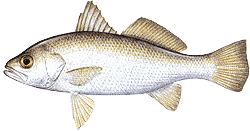
Color silvery with yellowish fins; no spots; no chin barbels; no prominent canine teeth at tip of of upper jaw: preopercle finely serrated; 5 to 6 chin pores; mouth terminal.
Where Found:
INSHORE in seagrass beds, tidal creeks and rivers, and marshes.
Size:
Small, not exceeding 9 inches.
Remarks:
Spawning takes place in shallow, saline portions of bays and other INSHORE areas, peaking between May and September; matures by second or third year (by 6 inches); adults eat crustaceans and small fish; may live to 6 years.
Spanish Mackerel

Color of back green, shading to silver on sides, golden yellow irregular spots above and below lateral line; front dorsal fin black; lateral line curves gently to base of tail.
Where Found:
INSHORE, NEARSHORE, and OFFSHORE, especially over deep grass beds and reefs; absent from north Florida waters in winter.
Size:
Average catch less than 2 pounds (20 inches).
Remarks:
Schooling fish that migrate northward in spring, returning to southerly waters when water temperatures drop below 70° F; spawns OFFSHORE, spring through summer; feeds on small fish and squid.
Spotted Sea Trout

Dark gray or green above, with sky-blue tinges shading to silvery and white below; numerous distinct round black spots on back, extending to the dorsal fins and tail; black margin on posterior of tail; no barbels; no scales on the soft dorsal fin; one or two prominent canine teeth usually present at tip of upper jaw.
Where Found:
INSHORE and /or NEARSHORE over grass, sand, and sandy mud bottoms; move into shallow waters in cold weather.
Size:
Common to 4 pounds on west coast, larger on east coast.
Remarks:
Matures during first or second year and spawns INSHORE from March through November, often in association with seagrass beds; lives mainly in estuaries and moves only short distances; adults feed mainly on shrimp and small fish; prefers water temperatures between 58 and 81° F, and may be killed if trapped in shallow water during cold weather; longevity 8 to 10 years.
Striped (Black) Mullet

Color bluish-gray or green above, shading to silver on sides, with indistinct horizontal black barrings, white below; fins lightly scaled at base, unscaled above; blunt nose and small mouth; second dorsal fin originates behind that of the anal fin.
Where Found:
INSHORE
Size:
Roe mullet common to 3 pounds but in aquariums known to reach 12 pounds or more.
Remarks:
Adults migrate OFFSHORE in large schools to spawn; juveniles migrate INSHORE at about 1 inch in size, moving far up title creeks; frequent leapers; feeds on algae, detritus, and other tiny marine forms.
Swordfish
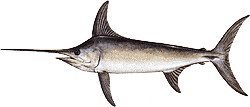
Color of back variable, black, grayish blue, brown, metallic purple, or bronze; sides dusty; underbelly dirty white; long, flat, sword-like upper jaw; lacks scales, teeth, and pelvic fins; single keel on each side of body in front of tail; first dorsal fin high, rigid and short; large eyes.
Where Found:
OFFSHORE worldwide species in temperate and tropical; known to frequent depths of 400 to 500 fathoms; also has been seen basking at the surface.
Size:
Once averaged 200 pounds, but over harvest has reduced size of commercially caught swordfish to average 48 inches.
Remarks:
Large swordfish are all females, males seldom exceeding 200 pounds except when spawning, females believed to prefer water cooler than that favored by males; feeds on squid, octopus, and pelagic fishes of all kinds.
Swordspine Snook
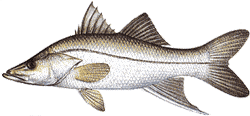
Smallest of the snooks; profile slightly concave; prominent lateral line outlined in black ( not solid ), extends above, silvery below; giant second anal spine, hence the name; largest scales of all snook.
Where Found:
Occurs in INSHORE estuarine habitats from south Florida as far north on the east coast as St. Lucie River.
Size:
Usually less than 1 pound ( 12 inches).
Remarks:
Full-grown adults are less than 12 inches long; mangrove shoreline habitats serve as nursery areas for young; rare on Florida’s west coast; prefers only slightly brackish of fresh water.
Tarpon Snook
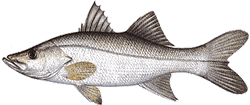
Only snook with 7 anal fin rays ( others have 6 ); lower jaw curves upward; compressed body; prominent black lateral line extends through tail; tips of pelvic fins reach beyond anus.
Where Found:
INSHORE in south Florida; frequently in fresh water.
Size:
Usually less than 1 pound ( 12 inches ).
Remarks:
Maximum size of 16 to 18 inches; feeds on small fish and larger crustaceans; young are nurtured along mangrove shorelines; rare on Florida’s west coast.
Tarpon

Last ray of dorsal fin extended into long filament; one dorsal fin; back dark blue to green or greenish black, shading into bright silver on sides; may be brownish gold in estuarine waters; huge scales; mouth large and points upward.
Where Found:
Primarily INSHORE fish, although adult fish spawn OFFSHORE where the ribbon-like larval stage of the fish can be found.
Size:
Most angler catches 40 – 50 pounds.
Remarks:
Slow grower, matures at 7 to 13 years of age; spawning occurs between May and September; female may lay more than 12 million eggs; can tolerate wide range of salinity; juveniles commonly found in fresh water; can breathe air at the surface; feeds mainly on fish and large crustaceans.
Vermillion Snapper
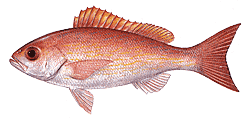
Color of entire body reddish, with a series of short, irregular lines on its sides, diagonal blue lines formed by spots on the scales above the lateral line; sometimes with yellow streaks below the lateral line; large canine teeth absent; orientation of mouth and eye give it the appearance of looking upward; no dark lateral spot.
Where Found:
Suspends at mid-depths over rocky reefs OFFSHORE.
Size:
Usually less than 1 pound.
Remarks:
Spawns April to September; females maturing at 3 to 4 years of age; grows slowly; attains a weight of 6 pounds and length of 24 inches; feeds on small, swimming crustaceans and mollusks.
Weakfish
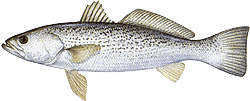
Dark olive or blue-green back; sides covered in tones of blue, purple, lavender, gold, and copper; irregular diagonal rows of vaguely-defined dark spots appear above the lateral line; 1 to 2 prominent canine teeth usually present at tip of upper jaw; black margin on tip of the tongue; pelvic and anal fins yellow; pectoral fins olive on outside, yellow underneath; mouth yellow inside.
Where Found:
An Atlantic coast fish, possibly found in the extreme southeastern Gulf; adults move INSHORE and north during warm months inhabiting the surf, inlet bays, channels, and estuaries; adults move OFFSHORE and south during cold months; juveniles inhabit estuaries which serve as nurseries.
Size:
2 to 3 pounds.
Remarks:
May mature as early as age 1; spawns in NEARSHORE or estuarine areas between April and October; schooling fish; feeds primarily on shrimp and fish.
White Marlin

Color of body dark blue to chocolate brown, shading to silvery white underbelly; noticeable spots on dorsal fin; upper jaw elongated in shape of spear; body covered with embedded scales with a single sharp point; tips of dorsal, pectoral, and first anal fins rounded; lateral line curved above pectoral fin, then going in straight line to base of tail.
Where Found:
OFFSHORE, a blue water fish.
Size:
Common to 8 feet.
Remarks:
Uses its bill to stun fast-moving fish, then turns to consume them; spawning procedures unknown; ranges throughout the Atlantic and Caribbean; feeds on squid and pelagic fish.
White Grunt
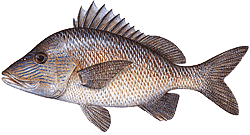 Body color light bluish-gray, head with horizontal blue stripes, white underbelly; black blotch on peropercle; margin of each scale bronze; large bright orange mouth; scales above leteral line larger than scales below lateral line.
Body color light bluish-gray, head with horizontal blue stripes, white underbelly; black blotch on peropercle; margin of each scale bronze; large bright orange mouth; scales above leteral line larger than scales below lateral line.
Where Found:
From SHORE to the outer reef edge or on OFFSHORE hard bottom to 115 feet; most abundant in water less than 80 feet deep; juveniles INSHORE.
Size:
Most catches 1.5 pounds (15 inches).
Remarks:
Audible grunting is produced by grinding of the pharyngeal teeth, with air bladder acting as amplifier; spawning occurs on OFFSHORE hard bottoms or reefs from May through June; feeds on crustaceans, mollusks, and small fish.
Yellowfin Grouper
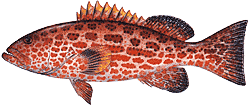
Color highly variable greenish olive or bright red with longitudinal rows of darker black blotches over entire fish; outer one-third of pectoral fins bright yellow; lower parts of larger fish with small bright red spots.
Where Found:
OFFSHORE on reefs off southern portions of Florida.
Size:
Common to 20 pounds.
Remarks:
Undergoes sex reversal from female to male in latter part of life; specific name translates to “venomous”, alluding to the fact that this fish, perhaps more frequently than other groupers, is associated with ciguatera poisoning; feeds on fish and squid.
Yellowmouth Grouper
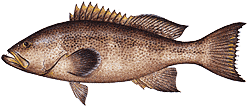
Color tan or brown with darker spots; spots, or a network of spots, fused into lines; distinct yellow was behind the jaws; yellow around the eyes; outer edges of fins yellowish.
Where Found:
OFFSHORE over reefs and rocks; not as common as Scamp in the Gulf; range limited to southern Florida.
Size:
Common to 15 pounds
Remarks:
Undergoes sex reversal, young individuals female, older individuals becoming male; young fish are bi-colored, dark above white below; feeds on small fish and crustaceans.
Yellowtail Snapper
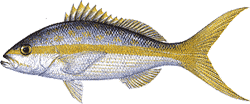
Back and upper sides olive to bluish with yellow spots; lower sides and belly with alternating narrow, longitudinal pink and yellow stripes; prominent midlateral yellow stripe begins at mouth and runs to tail, broadening as it passes the dorsal fins; caudal fin yellow and deeply forked; no dark lateral spot.
Where Found:
Juveniles INSHORE on grassbeds and back reefs; adults NEARSHORE or OFFSHORE over sandy areas near reefs.
Size:
Common to 3 pounds.
Remarks:
Found mainly in tropical waters; spawns in midsummer; rarely exceeds 30 inches and 5 pounds in size; feeds on small fish and invertebrates.



